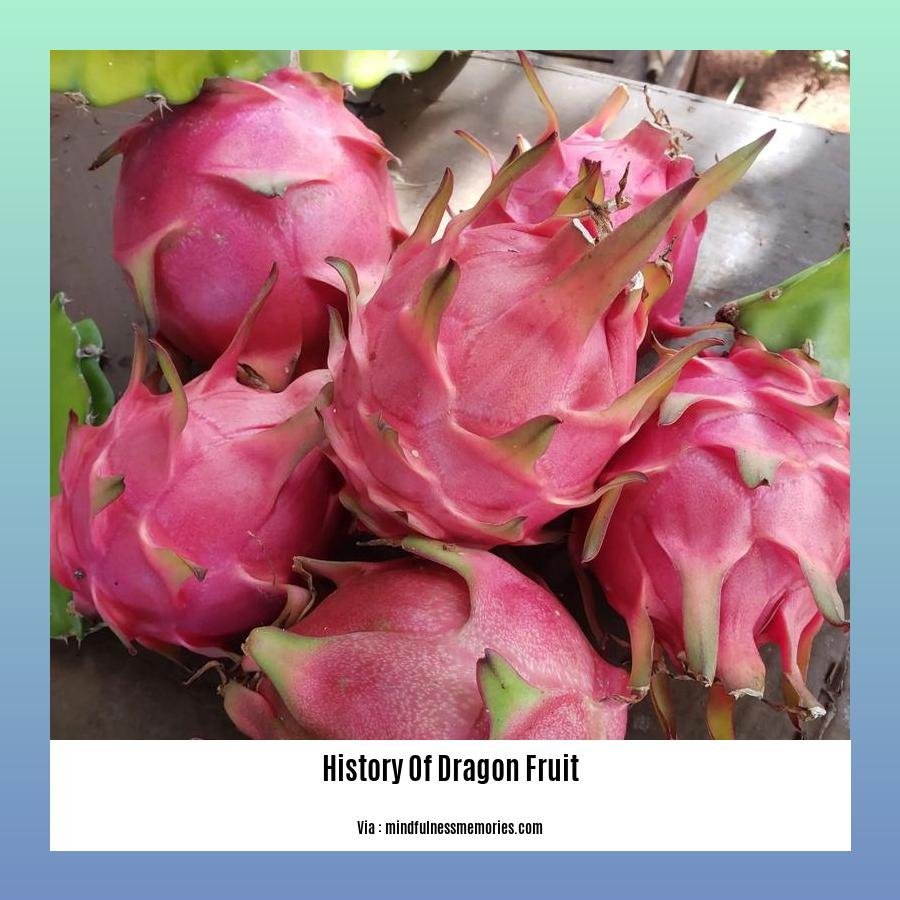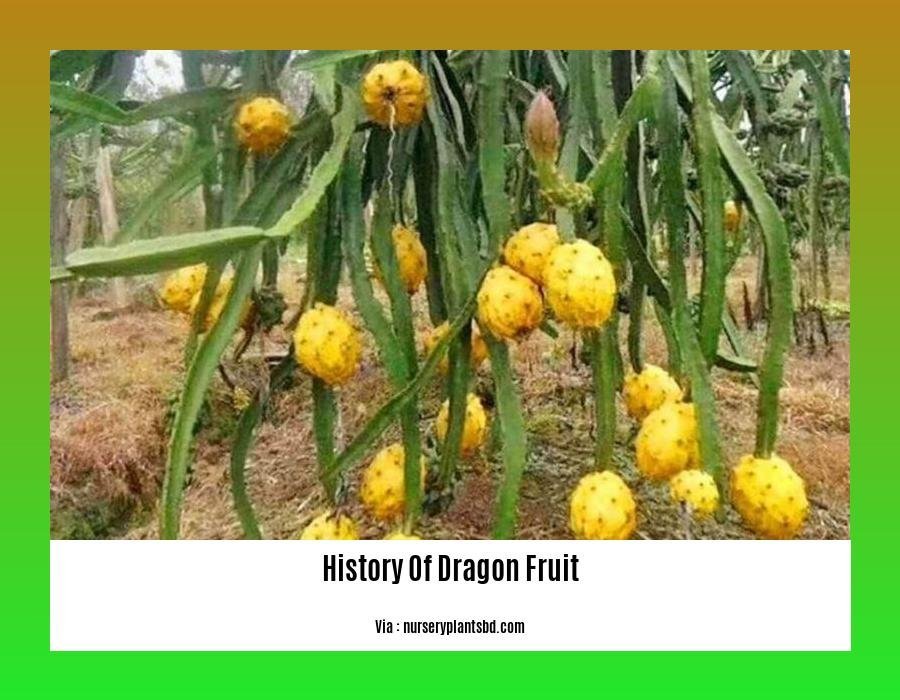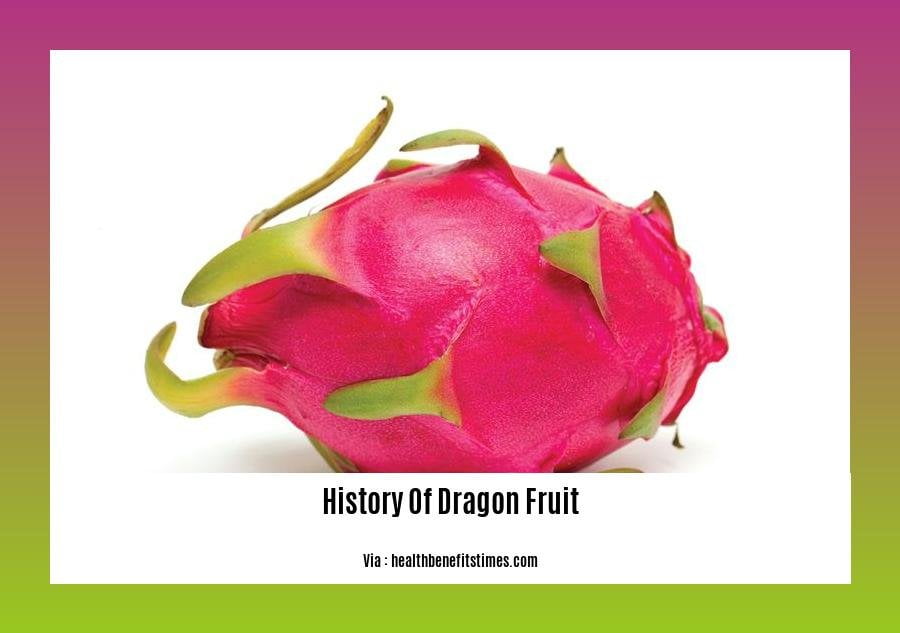Embark on a captivating journey through time as we delve into the enchanting history of dragon fruit, an exotic jewel that has captivated the world with its alluring appearance and tantalizing taste. From its humble beginnings in the tropical rainforests of Central America to its rise as a global culinary sensation, dragon fruit holds a rich tapestry of stories, legends, and cultural significance. Join us as we unravel the secrets behind this extraordinary fruit in [A Glimpse into the Enchanting History of Dragon Fruit: Unveiling Nature’s Exotic Jewel].
Key Takeaways:
Dragon fruit has historical roots in both Asia and Central America.
In Vietnam, dragon fruit was introduced by the French approximately a century ago.
Archaeological records indicate the fruit’s existence in Central America as early as the 13th century, with mentions in Aztec literature.
Its origin is traced to southern Mexico and South and Central America.
Central Americans refer to it as “pitaya,” while in Asia, it is commonly known as “strawberry pear.”
Dragon fruit comes in two distinct varieties: red-skinned and yellow-skinned.
History of Dragon Fruit:

Dragon fruit, a fruit with an appearance as captivating as its taste, boasts a history as rich and vibrant as its colors. Embark on a journey through time to discover the fascinating story of this exotic fruit.
Origins:
The dragon fruit, scientifically known as Hylocereus undatus, traces its roots to the tropical regions of Southern Mexico and Central and South America. Archaeological evidence suggests that this fruit was savored by the ancient Aztecs, who referred to it as “pitaya,” and its existence was documented in Aztec literature dating back to the 13th century.
Spread to Asia:
In the early 19th century, French explorers introduced the dragon fruit to Vietnam, where it quickly gained popularity and became a beloved fruit among the locals. Today, Vietnam remains one of the largest producers of dragon fruit in the world. From Vietnam, the fruit’s fame spread throughout Southeast Asia, earning it various names such as “strawberry pear” due to its unique flavor and appearance.
Modern Cultivation:
The popularity of dragon fruit has skyrocketed in recent years, leading to its cultivation in various tropical and subtropical regions around the world, including Thailand, Malaysia, the Philippines, and Central America. Today, this exotic fruit is widely available in international markets, captivating consumers with its vibrant colors and delicious taste.
Varieties:
The dragon fruit family boasts three main varieties:
- Red-Skinned: This is the most common variety, featuring vibrant red skin and white or pink flesh.
- Yellow-Skinned: Less common but equally delicious, the yellow-skinned dragon fruit has yellow skin and white flesh.
- Self-Pollinating: These varieties, such as ‘Honey Moon’ and ‘American Beauty,’ are ideal for home gardeners as they do not require cross-pollination.
A Symbol of Good Fortune:
In many cultures, the dragon fruit is considered a symbol of good fortune and prosperity. Its striking appearance and delicious taste make it a popular choice for festivals and celebrations. The fruit is often used as a decorative element or as an ingredient in traditional dishes, adding a touch of exotic flair to any occasion.
Ever wondered about the history of cocoa, and how the cocoa bean transformed into the chocolate we love today? Or how about how cookies came to be? Discover their journey here
Have you ever wondered how the cocoa bean, the foundation of our beloved chocolate, came to be? Immerse yourself in the history of cocoa beans and learn about the fascinating journey of this exquisite delicacy.
Arrival and cultivation in Southeast Asia

Southeast Asia, with its balmy tropical climate, provided the perfect environment for the dragon fruit to flourish and captivate local palates.
In the late 1800s, French missionaries, with their zeal for agricultural experimentation, brought dragon fruit to Vietnamese shores. From there, its popularity soared, and cultivation expanded like wildfire throughout Southeast Asia, transforming it into a vibrant hub for dragon fruit production.
Today, Southeast Asian countries like Thailand, Vietnam, and the Philippines stand as major producers, contributing significantly to the global supply of this exotic fruit.
Vietnam, in particular, has emerged as a notable player in the dragon fruit game. In the sun-drenched Binh Thuan province, a clever innovation has taken root: the use of night lighting to extend the cultivation period. This ingenious technique has fueled the province’s status as a major producer, supplying dragon fruit to the world.
The dragon fruit’s captivating beauty and tantalizing flavor have made it a beloved fruit across the globe. From tropical havens to subtropical havens, its cultivation has spread like a sweet melody, enchanting palates and shaping culinary landscapes wherever it goes.
Key Takeaways:
Southeast Asia’s hospitable climate proved ideal for dragon fruit cultivation.
French missionaries played a pivotal role in introducing dragon fruit to Southeast Asia in the late 1800s.
Thailand, Vietnam, and the Philippines have emerged as major producers of dragon fruit in Southeast Asia.
Vietnam’s Binh Thuan province has gained prominence through innovative nighttime cultivation techniques.
Dragon fruit’s popularity has soared globally, making it a sought-after fruit in tropical and subtropical regions.
Citations:
- History of Dragon Fruit
- Dragon Fruit Production in Vietnam
Spread to other parts of the world
Envisioned as a mythical creature come to life, the dragon fruit, with its vibrant hues and luscious taste, has captured the world’s imagination. Originally hailing from the Americas, this exotic fruit embarked on a remarkable journey, carried by the hands of explorers and traders, to find its new home in Southeast Asia.
In the 19th century, French explorers, with their insatiable curiosity and desire for new flavors, introduced this exotic fruit to the shores of Vietnam. The Vietnamese embraced the dragon fruit with open arms, recognizing its potential as a symbol of good fortune and prosperity. The fruit flourished in the tropical climate, thriving in the rich soil and abundant sunshine, becoming an integral part of Vietnam’s agricultural landscape.
From humble beginnings in Vietnam, the dragon fruit’s journey continued, extending its reach to neighboring countries such as Thailand, Malaysia, and the Philippines. Its distinctive appearance and delectable taste captivated the people of Southeast Asia, quickly becoming a beloved fruit, gracing tables and markets across the region.
Today, the dragon fruit is a global citizen, cultivated in tropical and subtropical regions worldwide. From Australia to Israel, and even in the tropical haven of Hawaii, the dragon fruit has found a home, adding its unique charm to the culinary landscapes of various nations.
Key Takeaways:
- Dragon fruit’s journey: Originating in the Americas, the dragon fruit was introduced to Southeast Asia by French explorers in the 19th century.
- Vietnamese embrace: The Vietnamese welcomed the dragon fruit, recognizing its cultural significance and potential for prosperity, leading to its widespread cultivation.
- Spread across Southeast Asia: From Vietnam, the dragon fruit’s popularity spread to neighboring countries like Thailand, Malaysia, and the Philippines, becoming a cherished fruit in the region.
- Global expansion: In recent years, the dragon fruit has extended its reach to tropical and subtropical regions worldwide, including Australia, Israel, and Hawaii, gaining international recognition for its unique appearance and taste.
Sources:
Where Does Dragon Fruit Come From? A Guide to Its Origins and Cultivation
History and Cultivation of Dragon Fruit
Modern-day popularity in global markets
In recent years, the dragon fruit has gained immense popularity in global markets, captivating consumers worldwide with its alluring appearance and unique flavor profile.
Factors driving the rise in popularity:
Visual appeal: The dragon fruit’s striking appearance, characterized by vibrant pink or yellow skin and black speckles, makes it a visually appealing fruit that stands out on supermarket shelves.
Taste and versatility: Dragon fruit offers a unique and refreshing taste, described as a blend of kiwi, strawberry, and watermelon. Its versatility as an ingredient allows it to be incorporated into various culinary creations, from smoothies and salads to desserts and beverages.
Health benefits: Dragon fruit is gaining recognition for its potential health benefits, including its high antioxidant content, which may contribute to improved immunity and overall well-being.
Key Takeaways:
- Global appeal: The dragon fruit’s popularity extends across continents, with demand in countries such as China, the United States, and many regions of Europe.
- Export growth: Vietnam, a leading producer of dragon fruit, has experienced a surge in exports to meet the growing global demand.
- Culinary versatility: Chefs and home cooks alike are embracing the dragon fruit’s unique flavor and using it to create innovative dishes and beverages.
Sources:
– Mordor Intelligence: Dragon Fruit Market
– ResearchAndMarkets.com: Dragon Fruit Market
FAQ
Q1: Where did dragon fruit originate?
A1: Dragon fruit, also known as pitaya, originated in Central and South America, particularly in southern Mexico and along the Pacific coasts of Guatemala, Costa Rica, and El Salvador.
Q2: How did dragon fruit arrive in Southeast Asia?
A2: French missionaries introduced dragon fruit to Southeast Asia in the late 1800s, where it gained popularity and became widely cultivated.
Q3: What are the different names for dragon fruit?
A3: In Central America, dragon fruit is called “pitaya,” while in Asia, it is known as “strawberry pear.”
Q4: What color varieties does dragon fruit come in?
A4: Dragon fruit comes in red- and yellow-skinned varieties.
Q5: When did dragon fruit become popular in tropical and subtropical regions worldwide?
A5: Dragon fruit has become a popular fruit in tropical and subtropical regions worldwide in recent years due to its unique appearance, sweet flavor, and potential health benefits.
- China II Review: Delicious Food & Speedy Service - April 17, 2025
- Understand Virginia’s Flag: History & Debate - April 17, 2025
- Explore Long Island’s Map: Unique Regions & Insights - April 17, 2025
















